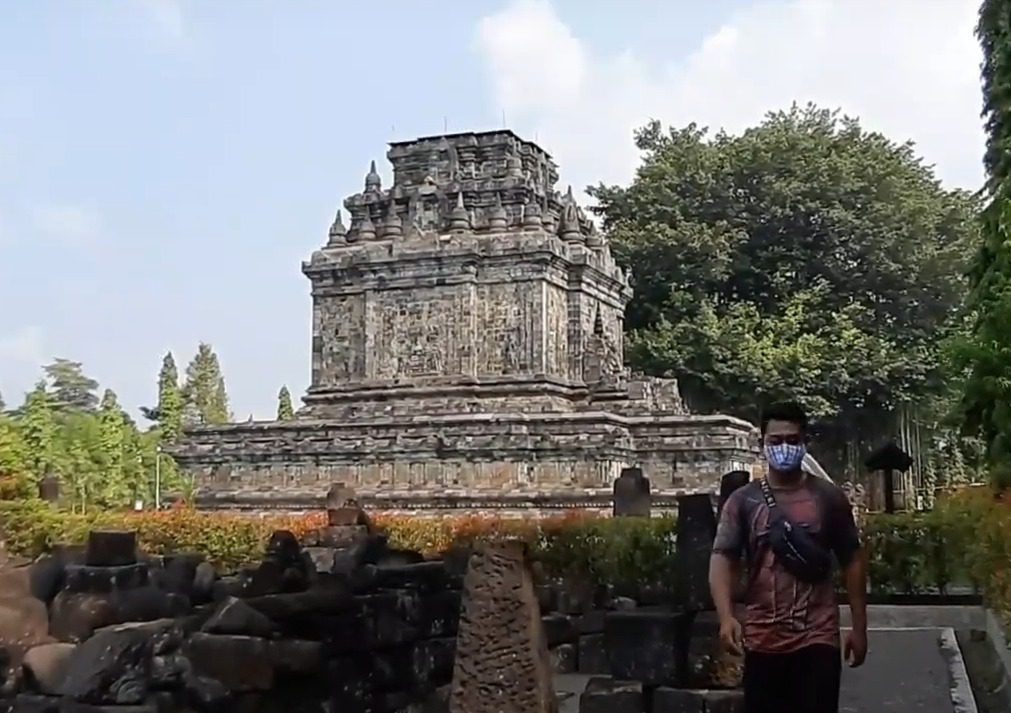A complete explanation of the Mendut Temple history. Mendut Temple, a Buddhist temple located in Magelang Regency, Central Java, has a rich and interesting history. This temple is one of the many architectural remains of Buddhism that was founded during the Syailendra Dynasty, which ruled Central Java in the 8th to 9th centuries AD. The Syailendra dynasty is known as the main patron of Mahayana Buddhism, which is reflected in the construction of many temples that function as places of worship and centers of learning for Buddhist teachings.
Mendut Temple is thought to have been built around 824 AD during the reign of King Indra. Written evidence regarding the founding of this temple is found in the Karangtengah inscription. This temple has a square building shape with a terraced roof decorated with small stupas. Inside the temple there are three large statues, namely Dhyani Buddha Vairocana, Bodhisattva Avalokitesvara, and Bodhisattva Vajrapani. The walls of the temple are also decorated with reliefs that tell Jataka stories, which teach Buddhist teachings through stories of previous lives.
Over time, Mendut Temple experienced damage and was buried by volcanic material. This temple was first rediscovered by the Dutch colonial government in the 19th century and has undergone several restorations. Currently, Mendut Temple is managed by the Cultural Heritage Conservation Center (BPCB) and is one of the important cultural heritage sites in Indonesia. This temple not only functions as a place of worship for Buddhists, but also as an attraction for cultural tourism and archaeological studies, attracting the interest of domestic and foreign tourists.
Read More: Abang Temple History, A Ruined Temple with Full of History
The History Mendut Temple Yogyakarta
Founding and Historical Background
Mendut Temple is thought to have been built around 824 AD, during the reign of King Indra from the Syailendra Dynasty. Written evidence regarding the founding of this temple is in the Karangtengah inscription dated 824 AD. In the inscription it is stated that King Indra built a sacred building called “Venuvana” which means “bamboo forest”. Several historians and archaeologists identify this Venuvana as Mendut Temple. This temple was built not far from Borobudur Temple, which is the largest Buddhist temple in the world and was also built by the Syailendra Dynasty.
Architecture and Sculpture
Mendut Temple has a square building shape with a terraced roof consisting of three levels, each of which is decorated with small stupas. This temple stands on a temple foot about three meters high which is equipped with stairs and an entrance on the west side. One of the distinctive characteristics of Mendut Temple is the presence of three large statues in the main room of the temple, namely the statue of Dhyani Buddha Vairocana who sits in the middle with his hands in Dharmachakra mudra (spinning the wheel of dharma), as well as two other statues, namely Bodhisattva Avalokitesvara on the right and Bodhisattva Vajrapani on the left. The existence of these statues shows the emphasis on Mahayana teachings.
Apart from the main statue, the temple walls are decorated with reliefs that tell Jataka stories, namely stories about Buddha’s lives before he achieved enlightenment. These reliefs not only have high artistic value but also function as a medium for education and the dissemination of Buddhist teachings to society at that time.
Religious and Ceremonial Roles
Mendut Temple, together with Pawon Temple and Borobudur Temple, forms a single religious ritual. Every year, especially during the Vesak celebration, this temple becomes one of the centers of Buddhist religious activities. The Vesak celebration at Mendut Temple begins with a procession from this temple, followed by a walk to Pawon Temple, and finally to Borobudur Temple. This procession symbolizes a spiritual journey and the search for enlightenment.
Rediscovery and Restoration
Over time, Mendut Temple experienced damage and was buried by volcanic material and vegetation. This temple was first rediscovered by the Dutch colonial government in the 19th century. The first restoration was carried out at the beginning of the 20th century under the supervision of Dutch archaeologist, Theodoor van Erp, who was also involved in the restoration of Borobudur Temple. This restoration aims to restore the temple structure to its original form and repair existing damage.
Cultural and Educational Significance
Currently, Mendut Temple is managed by the Cultural Heritage Conservation Center (BPCB) and is one of the important cultural heritage sites in Indonesia. This temple is not only a place of worship for Buddhists, but also an object of study for archaeologists, historians and culture lovers. The beauty of its architecture and sculptural art attracts domestic and foreign tourists, making Mendut Temple an important cultural tourism destination in the area.
With a long and meaningful history, Mendut Temple still stands as a silent witness to past glories and continues to function as a place of worship and a source of inspiration for present and future generations.
Location and Route to Mendut Temple
You can find Mendut Temple in Mendut Village, Mungkid District, Magelang Regency, Central Java. To reach it from Yogyakarta, you can take the Yogyakarta-Magelang Highway until you reach Mungkid District. At the traffic light junction, follow the directions to Borobudur Temple by turning left, then continue following the road until you find a sign pointing to Mendut Temple on the right.
Traveling to Mendut Temple can be done using private or public transportation from Yogyakarta. Tour packages from Yogyakarta also often include a visit to Mendut Temple, which is located about 3 kilometers from the popular Borobudur Temple. Even though it is in Central Java, access to this historical site is not too far from the center of Yogyakarta City, only around 38 kilometers.
Mendut Temple operating hours and facilities
Mendut Temple has extensive operating hours, allowing visitors to enjoy its beauty and rich history every day. From Monday to Sunday, this temple is open from 06.00 to 17.00 WIB. This long operational time allows visitors to explore the temple and enjoy the surrounding atmosphere more freely.
Apart from its architectural beauty and historical value, Mendut Temple also offers adequate facilities for its visitors. Among the facilities available is a large vehicle parking area, so that tourists can comfortably leave their vehicles. Apart from that, there are also clean and well-maintained toilet facilities for visitor comfort. For eating and drinking needs, there are eating places managed by the local community, offering delicious local dishes to enjoy after touring the temple.
For tourists who want to take home special souvenirs from their visit, Mendut Temple also provides various stalls selling souvenirs and local craft items. Visitors can find a wide selection of unique and interesting souvenirs in the temple complex or around the entrance gate. Thus, Mendut Temple not only offers a valuable spiritual and historical experience, but also provides convenience and comfort for its visitors.
This is complete information about the Mendut Temple history, complete with operating hours and facilities offered. Visit this tourist spot for a more enjoyable holiday with your family or colleagues.







